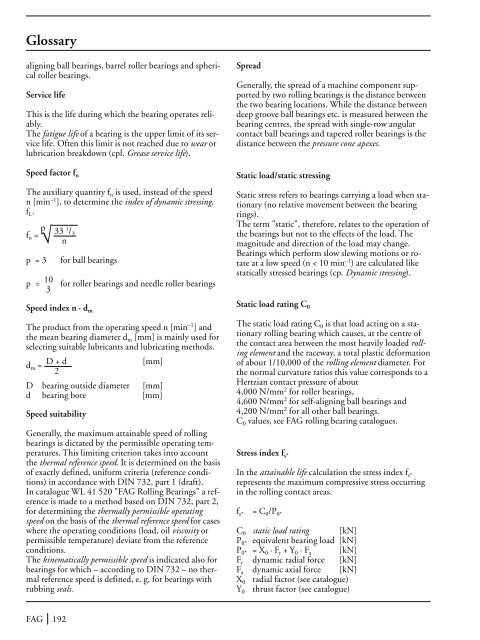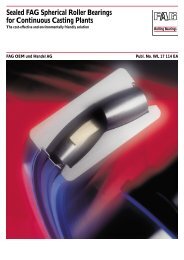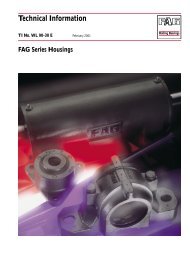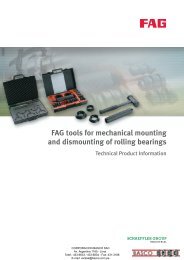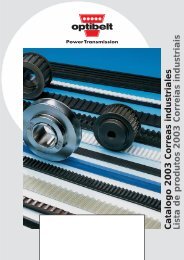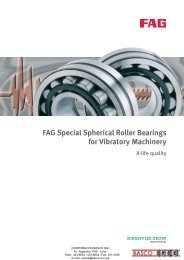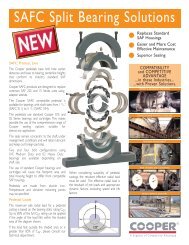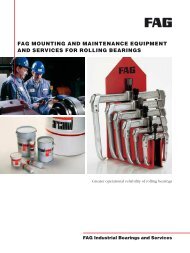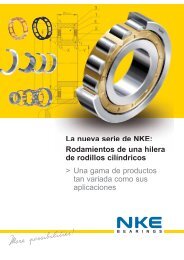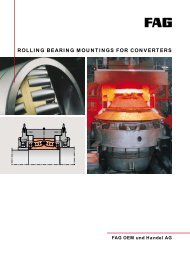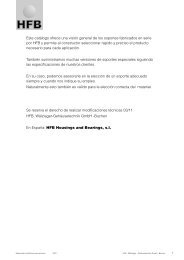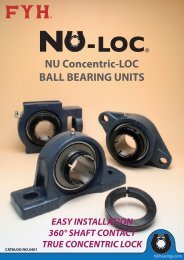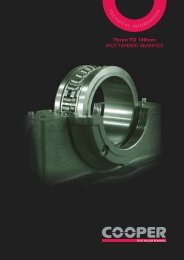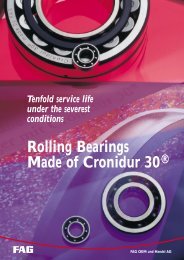Create successful ePaper yourself
Turn your PDF publications into a flip-book with our unique Google optimized e-Paper software.
Glossaryaligning ball bearings, barrel roller bearings and sphericalroller bearings.Service lifeThis is the life during which the bearing operates reliably.<strong>The</strong> fatigue life <strong>of</strong> a bearing is the upper limit <strong>of</strong> its servicelife. Often this limit is not reached due to wear orlubrication breakdown (cpl. Grease service life).Speed factor f n<strong>The</strong> auxiliary quantity f n is used, instead <strong>of</strong> the speedn [min –1 ], to determine the index <strong>of</strong> dynamic stressing,f L .f n = p √ 33 1 / 3np = 3for ball bearingsp= 10 for roller bearings and needle roller bearings3Speed index n · d m<strong>The</strong> product from the operating speed n [min –1 ] andthe mean bearing diameter d m [mm] is mainly used forselecting suitable lubricants and lubricating methods.d m = D + d[mm]2D bearing outside diameter [mm]d bearing bore [mm]Speed suitabilityGenerally, the maximum attainable speed <strong>of</strong> rollingbearings is dictated by the permissible operating temperatures.This limiting criterion takes into accountthe thermal reference speed. It is determined on the basis<strong>of</strong> exactly defined, uniform criteria (reference conditions)in accordance with DIN 732, part 1 (draft).In catalogue WL 41 520 "FAG <strong>Rolling</strong> <strong>Bearing</strong>s" a referenceis made to a method based on DIN 732, part 2,for determining the thermally permissible operatingspeed on the basis <strong>of</strong> the thermal reference speed for caseswhere the operating conditions (load, oil viscosity orpermissible temperature) deviate from the referenceconditions.<strong>The</strong> kinematically permissible speed is indicated also forbearings for which – according to DIN 732 – no thermalreference speed is defined, e. g. for bearings withrubbing seals.SpreadGenerally, the spread <strong>of</strong> a machine component supportedby two rolling bearings is the distance betweenthe two bearing locations. While the distance betweendeep groove ball bearings etc. is measured between thebearing centres, the spread with single-row angularcontact ball bearings and tapered roller bearings is thedistance between the pressure cone apexes.Static load/static stressingStatic stress refers to bearings carrying a load when stationary(no relative movement between the bearingrings).<strong>The</strong> term "static", therefore, relates to the operation <strong>of</strong>the bearings but not to the effects <strong>of</strong> the load. <strong>The</strong>magnitude and direction <strong>of</strong> the load may change.<strong>Bearing</strong>s which perform slow slewing motions or rotateat a low speed (n < 10 min –1 ) are calculated likestatically stressed bearings (cp. Dynamic stressing).Static load rating C 0<strong>The</strong> static load rating C 0 is that load acting on a stationaryrolling bearing which causes, at the centre <strong>of</strong>the contact area between the most heavily loaded rollingelement and the raceway, a total plastic deformation<strong>of</strong> about 1/10,000 <strong>of</strong> the rolling element diameter. Forthe normal curvature ratios this value corresponds to aHertzian contact pressure <strong>of</strong> about4,000 N/mm 2 for roller bearings,4,600 N/mm 2 for self-aligning ball bearings and4,200 N/mm 2 for all other ball bearings.C 0 values, see FAG rolling bearing catalogues.Stress index f s*In the attainable life calculation the stress index f s*represents the maximum compressive stress occurringin the rolling contact areas.f s* = C 0 /P 0*C 0 static load rating [kN]P 0* equivalent bearing load [kN]P 0* = X 0 · F r + Y 0 · F a [kN]F r dynamic radial force [kN]F a dynamic axial force [kN]X 0 radial factor (see catalogue)thrust factor (see catalogue)Y 0FAG 192


